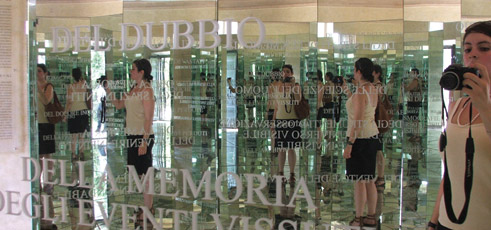Beyond Junior Year Abroad
By Laura Itzkowitz '09
Some of us are never satisfied. Our restless spirit of adventure takes over and we just have to pack our bags and head off toward the unknown. Sometimes, however, it's nice to find something a little familiar amid all the excitement.
It is in Rome, at the Villa Medici, that I've found, among my latest wanderings, the perfect synthesis of my old French—I'm a veteran of JYA Paris (2007-08)—and more recent Italian studies, begun in my senior year at Smith. The Villa Medici is the home of the Académie de France in Rome, founded in 1666 under Louis XIV and moved to its current location overlooking the city by Napoleon Bonaparte in 1803.
The académie's original mission was to host French artists in Rome so they could copy the great sculptures and reliefs of antiquity and the Renaissance. French painter Nicolas Poussin was to have been the first director, but he died before he could fill the position. His portrait still hangs in one of the suites of the villa.
I first had the opportunity to visit the Villa Medici earlier this year as a guest of one of the directors of art history and restoration, thanks to Hélène Visentin, associate professor of French studies at Smith. Her colleague and my host, Marc Bayard, told me about the history of the villa and the art it contains as he led me through the director's apartments, the grand salon where they hold concerts and events, and even into the attic—which is off-limits to the public—to see the very structure of the building. He informed me that the académie regularly holds concerts and other events, which I will certainly be attending in the future.
During the 19th century the académie was opened to musicians, and in fact welcomed some of France's greatest composers, including Debussy and Berlioz. Even the renowned architect of the Paris Opera House, Charles Garnier, lived and worked at the Villa Medici.
Today the académie welcomes francophone artists of any nationality to live at the villa and create original works of art in any medium.
Walking through the spacious terra-cotta tiled rooms of the Villa Medici, I keep thinking back to my art history course with John Moore, professor of art at Smith. Though it was titled The Age of Louis XIV, we spent about half the class discussing Italian artists in France and French artists in Italy.
I now understand the rich cultural exchange between the two great centers of artistic production that I have called home—Paris and Rome. As a member of neither culture but a scholar of both, I have a certain perspective that is not obscured by the nationalistic pride the French and the Italians are sometimes prone to.
I plan to use this neutrality to my advantage as I continue to explore all that these two great cultures have to offer.

The author in an installation by one of the artists currently in residence at the Villa.
|























